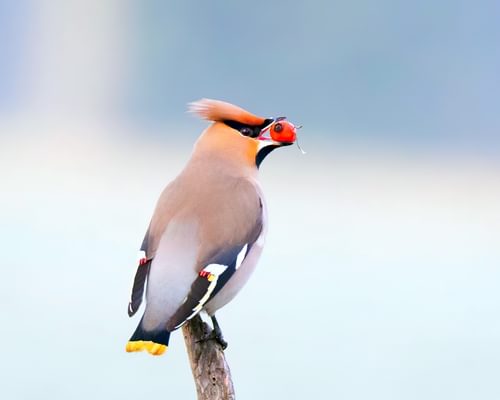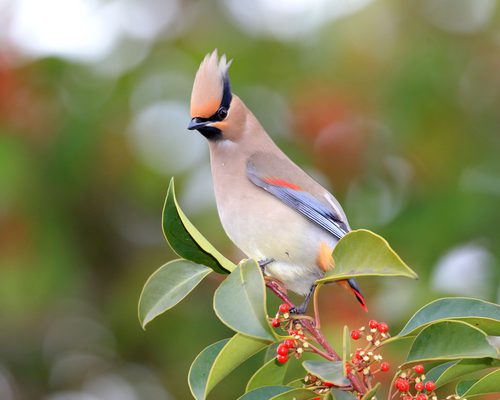Cedar Waxwing
Least ConcernBombycilla cedrorum
Visual Identification
Appearance
Cedar Waxwings are sleek, medium-sized songbirds with a distinctive crest and silky plumage. Their bodies are primarily pale brown, transitioning to soft gray on the wings and tail. The tail is tipped with bright yellow, and adults often have small red waxy tips on their wing feathers.
Both sexes look similar, with a black mask outlined in white, a pale yellow belly, and a yellowish undertail. Juveniles are streakier and lack the adult's sleek appearance and bright wing tips.
Size
Length
15cm to 18cm
Wingspan
22cm to 30cm
Weight
30g to 40g
Colours
Males and females have similar plumage
Primary Colour
Brown Grey
Secondary Colour
Yellow Red
Beak Colour
Black
Leg Colour
Black
Habitat and Distribution
Habitats
Woodland
Garden
Wetland
Coastal
Urban
Farmland
Grassland
Desert
Tundra
Rainforest
Mountain
Savanna
Distribution
Cedar Waxwings inhabit a variety of wooded and semi-open habitats across North America, from southern Canada to the northern parts of Central America. They show a preference for areas with fruiting trees and shrubs, including orchards, parklands, and suburban gardens.
During winter, they are more widespread in the United States and can be found in large numbers in the southern states. In summer, their breeding range extends further north into Canada and Alaska.
Elevation Range
Up to 2,200 meters
Climate zones
Temperate, Subtropical
Distribution Map
This map gives you a rough idea of where you might spot a Cedar Waxwing. The coloured areas show countries where these birds have been seen.
A few things to keep in mind:
- Birds might not be everywhere in the coloured areas, for example, they may be present around the coast of that country
- Where birds live can change with seasons and available food
- This map is quite simple - it doesn't show exact locations
We're working on making our maps even better! Soon, we hope to show you:
- More detailed maps for bigger countries, including state and region
- How birds move around during different seasons
Distribution by Region
Behaviour and Ecology
Bird Attributes
This feature is in beta. We'd love your feedback to improve it!
Share your thoughtsBird Attributes Explained
Our bird attributes system rates various aspects of a bird's capabilities on a scale of 0-100, based on data from field observations, scientific studies, and expert knowledge.
Attribute Categories:
- Agility: Manoeuvrability, speed, and grace in flight or movement.
- Strength: Physical power, often correlating with size and hunting abilities.
- Adaptability: Ability to thrive in various environments or changing conditions.
- Aggressiveness: Territorial behaviour and assertiveness, particularly during breeding seasons.
- Endurance: Stamina, often seen in migration patterns or foraging behaviours.
Understanding the Ratings:
- 0-20: Very Low
- 21-40: Low
- 41-60: Average
- 61-80: High
- 81-100: Very High
Remember, these attributes are relative to other bird species and don't necessarily indicate superiority.
Hover over the icon next to each attribute for more information.
Tap the icon next to each attribute for more information.
Agility
Reflects the bird's manoeuvrability, speed, and grace in flight or movement.
Cedar Waxwings display remarkable agility in their aerial manoeuvres, particularly whilst catching insects mid-flight and navigating through dense foliage. Their quick, direct flight pattern with sudden directional changes demonstrates excellent manoeuvrability.
Strength
Indicates the bird's physical power, often correlating with size and hunting abilities.
As small songbirds weighing between 30-40g, Cedar Waxwings possess modest strength relative to other birds. Whilst capable of carrying berries and managing basic nest construction, they aren't built for powerful activities or carrying heavy loads.
Adaptability
Represents the bird's ability to thrive in various environments or changing conditions.
These birds show impressive adaptability, thriving across various habitats from woodlands to urban areas. Their ability to process sugar efficiently, survive on an all-fruit diet, and adjust their feeding patterns between fruits and insects demonstrates remarkable ecological flexibility.
Aggressiveness
Measures the bird's territorial behaviour and assertiveness, particularly during breeding seasons.
Cedar Waxwings are notably non-aggressive birds, known for cooperative feeding behaviours such as passing berries between individuals. Their social nature and peaceful flock dynamics indicate a particularly gentle disposition amongst songbirds.
Endurance
Reflects the bird's stamina, often seen in migration patterns or foraging behaviours.
Whilst not marathon flyers, Cedar Waxwings demonstrate solid endurance through their partial migration patterns and sustained foraging activities. Their ability to maintain energy levels on a fruit-based diet and engage in extended periods of aerial insect catching suggests decent stamina.
Diet
Cedar Waxwings are primarily frugivorous, with a strong preference for berries, especially cedar berries, hence their name. They also consume insects, particularly during the breeding season.
Their ability to subsist on a diet of sugary fruits is unique among North American birds, aided by a specialized liver that processes sugar efficiently.
Behaviour
Cedar Waxwings are highly social, often seen in large flocks, especially when foraging. They are known for their cooperative feeding behavior, passing berries beak-to-beak down a row of birds.
These birds are also skilled flycatchers, sallying out from perches to catch insects in mid-air.
Vocalisation
Cedar Waxwings are not known for melodious songs but rather for their high-pitched, thin, and buzzy calls.
Their most common vocalization is a high 'seee' or 'sree,' often described as sounding like a tiny, squeaky dog toy. In flocks, they produce a chorus of trills and buzzy notes.
Nesting & Breeding
Cedar Waxwings typically form monogamous pairs during the breeding season, which runs from late spring to early summer. Courtship involves a charming ritual where birds pass small objects like flower petals or insects back and forth.
Nests are built in trees, often on a horizontal branch, using grasses, twigs, and plant fibers. Females lay 3-5 pale blue-gray eggs with dark spots. Both parents contribute to nest building and incubation.
Incubation lasts about 12-14 days, with nestlings fledging after another 14-18 days. Parents continue to feed fledglings for several days after they leave the nest.
Lifespan
The Cedar Waxwing typically lives for 5 to 8 years, with a maximum recorded lifespan of 8.2 years.
Like all birds, lifespan can be affected by factors including predation, habitat quality, disease, and access to food sources.
Conservation and Status
Global Conservation Status
Cedar Waxwings are currently listed as Least Concern due to their large range and stable population. However, they face threats from window collisions in urban areas and pesticide use that affects their insect prey.
Conservation efforts focus on maintaining diverse habitats with native fruit-bearing plants.
Birdwatching Tips
- Look for flocks in fruiting trees or shrubs, especially in winter
- Listen for their high-pitched, trilled calls
- Watch for their distinctive flight pattern: quick and direct with sudden changes in direction
- In North America, check parks and suburban areas with berry-producing plants
Additional Information
Quick Facts
Other names:
Cedar Bird
Family:
BombycillidaePredators
Did You Know?
- Cedar Waxwings can become intoxicated from eating overripe fermented berries.
- They are one of the few North American birds that can survive on a diet of fruit alone for several months.
- The red tips on their wings are not feathers but waxy secretions that may signal age or status.
Was this bird profile helpful?
Your feedback helps us improve our content
Thanks for your feedback!
Your input helps us improve our content.
Community Experience
Community Ratings
No ratings yet - be the first to rate this bird!
Latest Community Reviews
No reviews yet
Sign in to be the first to review
Community Reviews
Create Your Free Account Welcome Back!
Join our community to rate birds and share your experiences. Creating an account is completely free and only takes a minute. Sign in to your account to rate birds and share your experiences with our community.
Your information is secure and will never be shared.
By creating an account, you agree to our Privacy Policy.
Similar Birds
References
- 2
website: BirdLife International. 2021. Bombycilla cedrorum. The IUCN Red List of Threatened Species 2021: e.T22708153A137475540.
View source - 4
report, 2019: Partners in Flight; Rosenberg et al.
- 3
website, 2022: Partners in Flight
View source - 1
website: BBL - Longevity Records of North American Birds
View source

